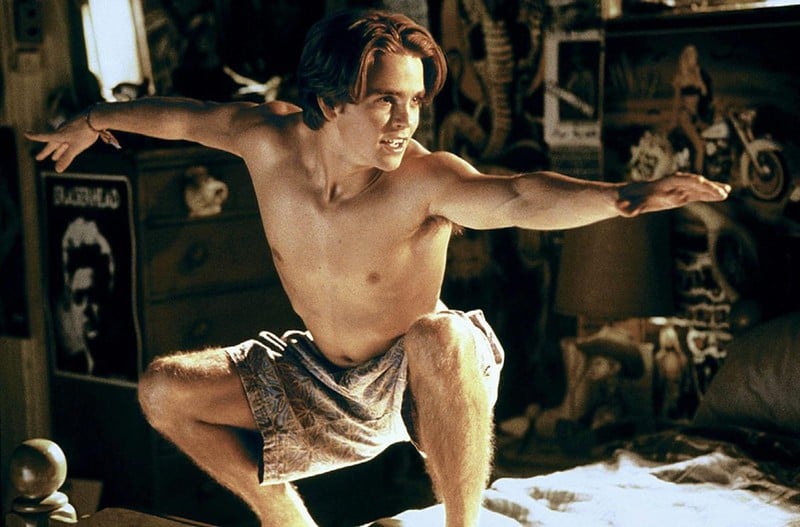This story is featured in CityBeat's Aug. 23 print edition.
On the eve of the 30th anniversary of the release of Rob Bowman’s Airborne (September 17, 1993, for those keeping track), it’s worth reflecting on the celebrated cinematic presence of the Queen City. Along with introducing audiences to Jack Black and Seth Green, the movie serves as a jumping off point for the emergence of Cincinnati as a city that’s more than a placeholder being namechecked in film and television titles like The Cincinnati Kid and the HBO series John from Cincinnati.
It's meaningful to me, personally, since I began my career as a freelance writer and film critic when I moved here in late 2000 and have found myself on a beat that has allowed me to document and, later on, even participate in the evolution of Cincinnati as a cinematic point on the map. We are a destination for film production, one of the best big cities to live in as a working filmmaker and the home of a really cool film festival. (Full disclosure, I am the artistic director of the Over-the-Rhine International Film Festival).
Mentions in publications like MovieMaker Magazine (both the city and our festival) have attracted more than a fair amount of attention to the Queen City. What’s most intriguing about Cincinnati cracking these industry lists is that we have been able to do so solely on the strength of film production. We haven’t had a major television or streaming series repping our fine city — unlike Breaking Bad in Albuquerque or The Bear in Chicago — so our ranking is based on the rising power of Cincinnati as an iconic setting and its healthy tax credits, which have attracted a stellar roster of filmmakers in recent years to not only come to visit and work, but remain and set up roots as well. That is how a city builds its creative base.
In recent years, my critical focus has been on representation and reflections, which, in this case, is about how we as a major city get to see ourselves onscreen and how authentic those representations are.
Watching it now, Airborne feels like a period piece, as it revels in its fish-out-of-water romantic comedy tropes about Mitchell Goosen (Shane McDermott), a teen moving to the city to live with extended family and struggles mightily to fit in alongside his cousin Wiley (Green). Coming from the West Coast, Mitchell has X-Games vibes that don’t mesh with the blue-collar Midwestern community. Remember, this is flyover country before the label stuck.
Of course, prior to Airborne, we had seen teen stories, even successful ones, rooted in Midwestern communities (think any John Hughes movie from the mid to late ‘80s), but Cincinnati couldn’t quite compare with the allure of suburban Chicago. What it did boast though was regional spunk that mirrored the sensibility of its protagonist (if you were willing to squint at him to offset his blinding cool that the bullies couldn’t see through their biffed-out glasses).
I found myself seeking something that was missing, some sense of the iconic and the familiar about Cincinnati. The climactic skating race down the Devil’s Backbone does its best to mimic the montage-like feel of Rocky Balboa’s training runs through the disparate streets of Philadelphia in Rocky, but even breaking the landscape down, scene by scene, there is a greater impulse to focus on what has been lost to time, rather than what remains as a nostalgic reminder.
What locations are comparable to Graeter’s Ice Cream and Skyline Chili? And maybe the better question is do we need to see those obvious cues like the Cincinnati Museum Center with its Hall of Justice majesty, Great American Ball Park, Washington Park (and its luminescent glory), Fountain Square or the bridges crossing over into Northern Kentucky, or can we quietly acknowledge our beautiful street art (thank you, ArtWorks) and our historic architecture that tethers the region to its urban American roots?
Airborne falls just short of approximating that time capsule longing, but it did unveil a mirror for audiences, both local and far beyond, so that now Cincinnati shines and sometimes dresses up as another starry mythic city that speaks to what it is that makes us all American dreamers.
Cincinnati playing a role (as another city)
A Rage in Harlem (1991)
Predating Airborne, Bill Duke’s A Rage in Harlem finds Cincinnati boldly playing a version of New York with moxie to spare as a gangster’s moll (Robin Givens) hightails it to Harlem with stolen gold and the rest of her gang hot on her heels. This is jazzy and snazzy in all the ways one would want, but Cincinnati is deep undercover as a seedier part of the city that never sleeps. Duke knew the look and feel he wanted and was ably abetted by a cast that included Forest Whitaker, Gregory Hines and Danny Glover. While there’s a certain comedic effort on display, Duke found the rage in the source material (from the great Chester Himes) and infused the proceedings with an overdose of violence that left the scene covered in spilled blood.
Carol (2015)
Todd Haynes delves into the noir-kissed world of Patricia Highsmith in this adaptation about an eager and aspiring photographer (Rooney Mara) who encounters an older woman (Cate Blanchett) and becomes emotionally and sexually intertwined in the repressive ‘50s. Once again, Cincinnati serves as a doppelgänger for New York, but this time, not only is the setting allure, but also the period. The city is shot to accentuate the glorious feel of the ‘50s in the cityscapes, while retreating to the quaint moments that would be expected outside the confines of the big city. It is in those moments that Cincinnati as New York disappears and the screen takes on the feel of a Midwestern hideaway, a closeted and secretive haven always on the verge of violent discovery.
Miles Ahead (2015)
Late career Miles Davis with Don Cheadle masterminding the proceedings both in front of the camera (as the incomparable jazz great) and behind the scenes (as co-writer along with Steven Baigelman and Stephen J. Rivele and in the director’s chair). This isn’t a truly based-on-a-true-story take on Davis; instead, it is inspired by the kind of blue creative escapade Davis might have imagined for himself before heading into the studio towards the end of his career. If you can imagine a hard hip-hop merging of Davis playing his social music with all the flair of a gun-toting gangster from Walter Mosley’s oeuvre, you might find yourself on the right street corner with the perfect view of all the action. And with Cincinnati standing in for New York, there is a fascinating game astute watchers can play with themselves as they wander Main Street in Over-the-Rhine after a home screening. Do you see OTR or New York and can this game transport us to a sketchier place that might even look like Davis in Spain?
The Old Man & the Gun (2018)
This one stretches Cincinnati by extending the regional connection to Dayton. David Lowery, as co-writer with David Grann and director, presents a version of the story of Forrest Tucker (Robert Redford) who escaped from San Quentin at the age of 70 and apparently went on to pull off a string of bank heists that bedeviled the authorities — except for the persistent John Hunt (Casey Affleck) — and charmed the public to no end. The region wears its own homespun appeal in much the same way as Tucker in squint-and-you-might-miss-it moments, where the skyline or a street corner pop up and nearly wink at audiences, as if to say, “Hey, now you see me, right?” It’s not dressed to the nines for a major performance as something other than what it is, which is when Cincinnati is at its best.
Extremely Wicked, Shockingly Evil and Vile (2019)
Covington and Cincinnati, but not. And really, what city wants to be associated with Ted Bundy, even a Bundy played with muted yet devilish charm by Zac Efron? This based-on-a-true-story vision of Bundy comes courtesy of his longtime companion Liz (Lily Collins) who maintained a relationship with him for years during his infamous crime spree and had to confront the truth about him, along with the rest of the world, as he pleaded innocence in a nationally televised trial. One could argue that Cincinnati not playing Cincinnati is a lighter version of Bundy’s dark twist.
Cincinnati reflections
Traffic (2000)
Traffic is a story told in at least three settings with Cincinnati playing such a prominent role as the home of a conservative judge, now the newly appointed drug czar for the United States struggling to support his heroin-addicted daughter. This is every parent’s nightmare and the fact that it takes place in an affluent Cincinnati suburb is even more telling and prescient. The film was released in January of 2001 and within a few months, the city was ground zero for rioting and civil unrest after the killing of Timothy Thomas in Over-the-Rhine. What better juxtaposition did the community and the country as a whole need than this black-and-white dynamic of criminal justice? Indeed, this was reel-to-real life writ large, but it wasn’t merely a Cincinnati story; these situations were unfolding in cities across the country and the police attacks on Black citizens were only going to get worse, but Cincinnati, thanks to the Collaborative Agreement that would emerge as a result of the Thomas shooting, would become a leading example of how an urban community can join forces to create meaningful change.
The Ides of March (2011)
What is it about Midwestern stars as idealistic politicians? From Dayton native Martin Sheen on The West Wing to local heartthrob George Clooney as co-writer (along with Grant Heslov and Beau Willimon) and director of The Ides of March, which focuses on a young staffer (Ryan Gosling) confronting the shadier side of the campaign trail. Clooney isn’t some coastal liberal elite shoving his highbrow progressive bona-fides down our throats; he’s reminding us that he learned these principles right here and continues to wave that banner for all the world to see.
The Killing of a Sacred Deer (2017) & My Days of Mercy (2017)
It is worth linking these two films together because they started a mini-roll for Cincinnati narratives on the fall festival circuit. As a critic who has attended the Toronto International Film Festival religiously since 2009, I was overwhelmingly proud to rep the Queen City alongside these two films. I can’t confirm this, but very likely I probably wore Cincinnati-centric t-shirts to both screenings. And, truth be told, I was paying special attention during The Killing of a Sacred Deer because I had been informed by the owners of local winery Revel OTR Urban Winery that there was a chance their wines were featured in the film, and I wanted to be able to confirm that for them when I returned. (And, indeed, a few bottles were clearly recognizable). Having writer-director Yorgos Lanthimos (and a couple of noted performers like Nicole Kidman and Colin Farrell) sojourn to Cincinnati to make one of his quirky dramas was certainly a unique and distinct honor — while introducing audiences to Barry Keoghan — but the remarkable aspect of the film is how subtle and creepy the city feels as part of his surreal vision. The usual stark realities we’ve been familiar with for how we see the ‘nati give way to the thrilling fun of Cincinnati as a dark and twisted hellscape out of The Twilight Zone.
The other feature here, from director Tali Shalom-Ezer and writer Joe Barton, is a far more traditional indie romantic drama that finds its two protagonists — Mercy (Kate Mara) and Lucy (Elliot Page) — on opposite sides of the death row debate. As heavy as it sounds, there’s a quiet intensity in the frames, which are teeming with raw Midwestern ordinary-ness on full display. By the time the film ends in the alley beside The Esquire in Clifton, Cincinnati couldn’t be any more grounded and American if it tried.
Dark Waters (2019)
Todd Haynes seemingly discovered his creative home base in the Queen City, but that is not to say that he has had rose-colored glasses on to obscure him from the dark side of our history. Teaming up with a bevy of screenwriters (Nathaniel Rich, Mario Correa and Matthew Michael Carnahan), Haynes set out to explore the determination and diligence of Rob Bilott (Mark Ruffalo), a corporate defense attorney who took on the quintessential David versus Goliath environmental lawsuit against a chemical company with a longstanding history of pollution. Set in 1998, the story is based in Cincinnati, but spreads throughout the region (into West Virginia) as angry farmers beg the upstart lawyer to go after the chemical multinational Dupont. Bilott is a scrappy plugger, a Midwestern man with a strong sense of right and wrong who simply cannot walk away from a case that puts every aspect of his own life at risk. What this film reminds us is that the everyman is without a doubt Midwestern.
The Public (2018)
This was another film, a year later, that stormed into Toronto and had me wearing my pride on my chest. Cincinnati couldn’t be more Cincinnati than it is in the Emilio Estevez drama The Public, which capitalizes on a huge social justice issue as it documents the battle between the police and a group of homeless citizens who seek shelter in the public library during a bitterly cold winter. The film is written, directed by and stars Estevez, but much like Ruffalo’s character in Dark Waters, he’s playing an everyman caught in the middle of a crisis with far more than two sides and it is truly amazing to watch the narrative reveal itself and all of its players without Estevez losing sight of his character or drawing too much attention to himself. That, in many ways, is the genius of Cincinnati. We are a major city taking flight, but still cruising just underneath the radar. It makes you wonder though — how much longer can this status last?
Subscribe to CityBeat newsletters.
Follow us: Apple News | Google News | NewsBreak | Reddit | Instagram | Facebook | Twitter | Or sign up for our RSS Feed






